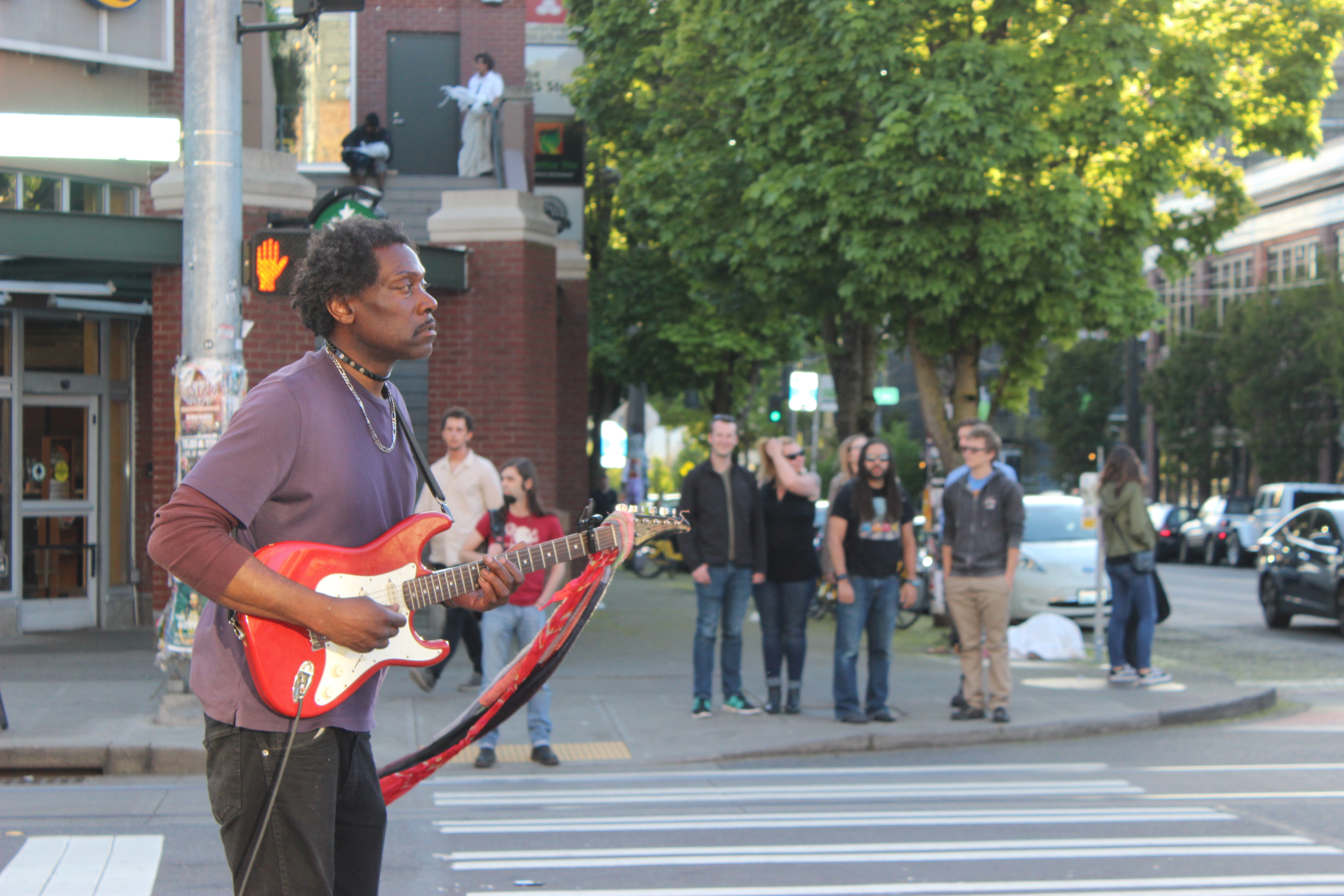
The Rich History of Capitol Hill
Written by Vincent Trey, 05/17/2018
Who are the elites of Capitol Hill? Most people who set foot on Capitol Hill are the elites; we make the heart of this place pump life into the streets here. People move through the streets of the neighborhood as blood does through veins, supporting life with its energy.
I believe that everyone here is a part of the reason why Capitol Hill is the great place that it is. There are the students of Seattle Central that occupy the south part of the neighborhood, in and out of class and patronizing the surrounding local small businesses, helping keep them alive. There is the guy standing at Dick’s playing music for everyone to enjoy, who always has a smile for anyone who will receive it, regardless of what you hand out to him.
There are sounds of music all around the neighborhood. In one corner, a local street musician plays his electric guitar. As pedestrians walk by enjoying the scene with laughter, there are some who even dance along with those tunes as they cross the street. There is never a dull moment here, or at least it would be really hard for me to believe so. Anywhere you go, there is something interesting to learn about. A woman walking down the street with a cat chilling on her shoulder is so cool. Who knew that a cat could be leashed?
Historically an art district, Capitol Hill has always been a refuge for creative minds.
There are dance and art studios all around and independent theatres to enjoy performances and films. That newer building with a big spotlight-studded sign that reads “12th AVE ARTS” is wholly dedicated to art and was made for artists. Just walking around the area stirs creative juices in a person.
There are many things to enjoy here on Capitol Hill. We have the perfect view of the city and Lake Union just west of us. Owning a car is unnecessary with the metro buses, Link Light Rail, and street cars, enabling us to easily access the rest of Seattle. The street car will get you a quick view of Broadway south and just a few minutes after that, there is the Chinatown International District. Lake Washington to the east for boat outings and water play, or just a stop away north on the Link Light Rail for a day out canoeing at the UW Waterfront Activity Center. We do not need to go far at all.
If you need a break from all the sounds of these busy movements, just a few blocks from here in north Capitol Hill are the homes of Millionaire Row. A walk through there mirrors a walk in a fancy park, except these homes are lived in. They are not what we usually see around the city. They are the exact prestigious vision they were meant to be. James A. Moore developed this area in the early 1900s for a different type of elite. For the richest of the rich to be able to enjoy all the beauties of the city and not be in all the noise, which was the ugly part to them.
On the very top of the hill lies the best view of the whole city. Lined with houses of the finest early 20th century homes, they are built with stones, brick, granite, and a wood mixture that compliments each other well. In the middle of Millionaire Row is a huge brick mansion that was owned by the very James A. Moore himself. Following the Alaskan-Yukon gold rush and the rebuilding of Seattle after the Great Fire of 1889, folks with big money needed places to live and show off their affluence.
Capitol Hill was the last to be established after the rest of Seattle was developed into a big commercial district, thanks to Henry Yesler and his steam powered sawmill, a new technology at the time. As other, better mills came up around Puget Sound, Seattle had to find new ways to stand out. This was when big prospectors were only thinking of growth in the commercial industry, with a pipe dream to transform Seattle from a small town into a big city. It was Moore who wanted something for the people, realizing that the city could not just have jobs and businesses. He was thinking about homes and communities for families to grow and emerge. Seeing the hill as the only space left, he envisioned a perfect community and made it work beyond his initial dreams. His idea changed the direction of how this part of the city grew.
After families came in, there was a clear need for a place to hang out and relax. With spaces being limited, the City Council decided that the Washelli Cemetery would be better used as a park. They had to dig up graves and move the bodies elsewhere. They named it Lake View Park, then City Park, and now, since 1901, it has come to be known as Volunteer Park. It was named in honor of the volunteers in the Spanish American War.
If we are to say we love a place, we must also give love and respect to its history and the origins of it.
The city of Seattle was named after the great Chief Si’ahl of the Duwamish Tribe. The Duwamish have been here long before any of us as the First People. They had sustained the land without destruction to it and they were able to maintain a great way of life. This lasted until the first wave of European American settlers pushed them out in 1851. The Duwamish are still here today, and we owe a big thanks to them for sharing this land with us.
Chief Si’ahl was known as “friend of the whites” as he befriended and helped the new settlers. He had a curiosity of and love for European artifacts. He was even able to persuade David S. “Doc” Maynard to move his trade company over to Seattle from Olympia, so he would not have to travel far to trade. Doc named the new store Seattle Exchange, and later convinced the other settlers to rename the town in honor of the chief. It is also interesting to note that the chief was baptized into Christianity and was given the name Noah Sealth. His eldest daughter, Kikisoblu, was also baptized and renamed as Princess Angeline by the wife of Doc Maynard, Catherine.
Kikisoblu lived her life refusing to leave her homeland at the Seattle waterfront and was laid to rest here at Lake View Cemetery. She was buried next to her friend, Henry Yesler, along with other Seattlite pioneers like Arthur Denny, Doc Maynard, Dexter Horton, and Thomas Mercer. Oh, and a horse named Buck. I have also read that the story of the man in the tree. Legend has it, during the Depression the cemetery had grave diggers who stayed in a shed on the property. One of them did not care to sleep in the shed and slept in a tree. That is where he remains to this day, as the past stays with us. He has been watching over through time scaring away couples who threaten the serenity of the park.
Throughout history there have been movements back and forth between the types of people who live here. One thing is sure though: the recent history is largely made up the LGBTQ community, who had found refuge on Capitol Hill, after they were pushed out of Pioneer Square. Since then, they have carved out a space for themselves and thrived in making it safe. This is important because this place and its particular atmosphere, is an asylum for anyone who needs a safe place to be themselves. What Capitol Hill is today cannot be replicated to that level anywhere else, not now and I do not believe ever.
With that being said, there is an imminent threat impending on the current Capitol Hill community. The new expansion of Amazon and the change in Seattle’s makeup and demographics is encroaching on the hill. The cost of living is going up and rent is getting too expensive. Historic buildings and homes are getting torn down only to be replaced by new buildings that lack the rich history of the ones before them. We, as the current elite of the historical arts community, have the responsibility to be aware. Capitol Hill had a rich history, and now it is the rich that are threatening it.


